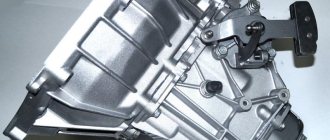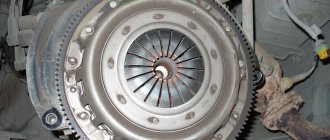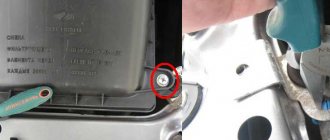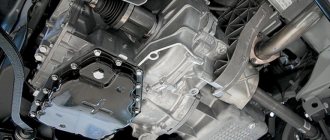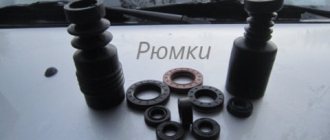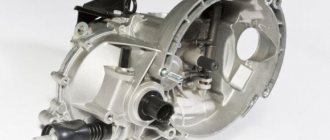In 2013, AVTOVAZ decided to modify the manual transmission (manual transmission 2180). A cable replaced the gear shift drive with rods. The design of the box was modernized, and the following serial number was added to the name (manual transmission 2181). Let's look at the features of a cable gearbox.
Technical characteristics of the VAZ 2190 gearbox
| Type | Mechanics |
| Number of gears | 5 |
| For drive | front |
| Engine capacity | up to 1.6 liters |
| Torque | up to 150 Nm |
| What kind of oil to pour | Lukoil TM-4 75W-90 GL-4 |
| Lubricant volume | 3.1 liters |
| Change of oil | once every 70,000 km |
| Replacing the filter | every 70,000 km |
| Approximate resource | 150,000 km |
Disadvantages, breakdowns and problems of the Lada Granta box
This transmission has low reliability, and it is also very noisy.
The clarity of manual transmission shifts leaves much to be desired and deteriorates over time.
Oil leaks often appear at low mileage and it is better not to ignore them
Wear on the plastic bushings will prevent you from locking the gear the first time.
Active use quickly affects the synchronizers and then the gears
You can contact the site administrator by email: [email protected]
All texts were written by me, are authored by Google, included in the original Yandex texts and notarized. For any borrowing, we immediately write an official letter on company letterhead in support of search networks, your hosting and domain registrar.
Next we go to court. Don’t try your luck, we have more than thirty successful Internet projects and have already won a dozen lawsuits.
In 2013, AvtoVAZ decided to modify the manual transmission (manual transmission 2180). A cable replaced the gear shift drive with rods. The design of the box was modernized, and the following serial number was added to the name (manual transmission 2181). Let's look at the features of a cable gearbox.
4_no_copyright
The single-rod gear shift drive was replaced by a cable. The unpleasant vibrations on the lever are gone, there is less play, and shifting is clearer.
It is curious that in the clutch drive, on the contrary, they planned to abandon the cable in favor of hydraulics. Unfortunately, for economic reasons, they left the previous design, although the hydraulic drive has better characteristics. In particular, the clutch pedal works more logically and clearly with it. The advantages in the layout are also obvious: it is easier to lay tubes and hoses. But the cable for the new box had to be lengthened. These are unnecessary mechanical losses, which means additional effort on the pedals and worse information content.
Comparison of manual transmission 2180 and manual transmission 2181
The difference between the two boxes is significant:
- Instead of rigid rods, a cable is used (Japanese company Atsumitec). Due to this, vibration on the body and gearshift knob is reduced.
- Multi-cone synchronizers were installed in 1st and 2nd gears. This increases the service life of the components and reduces the effort when engaging gears.
- The clutch diameter was increased to 215 mm. In this regard, it was necessary to use a different crankcase, and place the starter not along the box, but along the engine.
- The bevel angle of the synchronizer teeth was reduced (from 125 to 100º), as well as the preload force (from 150 to 70 N). This made switching easier.
- The gear selection mechanism has been newly developed (Schaeffler Group).
- The gear selection mechanism was moved from bottom to top. This made it possible to eliminate oil leaks and make gear shifting easier in cold weather.
- The design of the gear selection mechanism includes a selector plate, providing a clear gear shift pattern.
- The mechanism includes a lock to prevent accidental reverse gear.
- The oil volume in the gearbox decreased from 3.3 liters to 2.2.
- From the factory, the gearbox is filled with semi-synthetic instead of mineral water.
Synchronizers
They decided to change the gear part a little. Multi-cone synchronizers were installed in first and second gears, which increased the reliability of the unit and reduced the effort when engaging these gears. In the future, the Lada Granta VAZ-2181 box will be installed on cars with more powerful engines, so the diameter of the clutch, which has a larger moment of inertia, has already been increased. On the old manual transmission, the clutch housing accommodated a maximum disc size of 200 mm; the new housing allows the installation of 215 mm discs. These changes forced the developers to change the location of the starter; it is now located along the engine, and not along the box, as before.
It is noteworthy that the first samples of the new Granta box used three-cone synchronizers, but later it was decided to opt for double-cone synchronizers. They have a sufficient reserve of torque transmission, but at the same time they are much cheaper to manufacture and do not require such high manufacturing precision. A new set of synchronizer wheels ensures smooth and efficient synchronization. The German company Hörbiger, which produces these parts, applies an additional coating to them, which ensures stable operating parameters and reduces wear.
Schemes and design of manual transmission 2181
Main elements of the VAZ-2181 gearbox:
1 – main gear drive gear; 2 – secondary shaft; 3 – input shaft; 4 – fifth gear fork; 5 – fork for selecting third and fourth gears; 6 – reverse light switch; 7 – clutch housing; 8 – gear shift mechanism; 9 – central lock.
Device of synchronizers of VAZ-2110 (A) and -2181 (B) boxes:
1 – first gear gear; 2 – intermediate rings; 3 – blocking ring; 4 – synchronizer clutch; 5 – synchronizer clutch hub; 6 – clamp; 7 – second gear gear.
Gear selection mechanism:
1 – gear selector levers; 2 – selector grid pin; 3 – selector grid; 4 – reverse locking mechanism; 5 – central three-dimensional plate.
7_no_copyright
1 — gear selector levers;
2 — selector grid pin;
3 — selector grid;
4 — reverse locking mechanism;
5 - central three-dimensional plate.
However, the developers are not delaying documentation on the hydraulic drive and plan to launch it into series. As well as other improvements, by the way, which for various reasons were not implemented this time. For example, a multi-cone synchronizer in third gear and an equally interesting solution that makes the transition to the fourth and fifth stages clearer and more enjoyable. Not otherwise, appetite comes with eating. By the way, the food turns out delicious - I tried it myself. The main thing I would like to wish to the developers is not to be late with changing dishes. And to consumers - bon appetit!
Thank you for your help in preparing the material.
AVTOVAZ’s developments do not stand still, and in 2013 the company’s management, together with the design department, decided to switch to a new type of cable-driven gearbox. These gearboxes are installed on Lada Granta and Kalina 2 cars.
Appearance of the gearbox
What did you get?
The design of the gearbox was not only optimized and made more reliable, but also almost completely eliminated unpleasant vibrations on the lever and the car body. The backlash has become smaller and the shifts are clearer. It is worth noting that the use of a modernized gearbox on the Lada Granta and Lada Kalina 2 entailed an increase in the cost of these cars by an average of 5,000 rubles. By the way, the cable box is not installed on the Lada Priora; this car uses a 2180 manual transmission with rigid rods.
Let us remind you that according to reviews, the first copies of the modified gearbox were not entirely successful. The owners noticed a decrease in vibrations, but encountered a new problem: the box began to howl. After this, AvtoVAZ made changes to the design, but the sediment remained...
Automatic transmission Lada Granta
This gear shift mechanism is a classic Jatco design. The transmission is installed on Lada Granta modifications equipped with a 16-valve power unit with a capacity of 98 horsepower. Automatic transmissions from this company are also installed on available modifications of the Nissan Note and other similar cars. For the Lada Granta car engine, which works in conjunction with automation, a special aluminum sump was developed. The developers firmly attach this housing to the power plant. Note that the oil pan for such a transmission is made of steel.
The photo below shows what the automatic transmission handle looks like from inside the car:
This photo shows what the automatic transmission looks like from under the car:
A Lada Granta car equipped with an automatic transmission developed by Jatco will cost the consumer an average of 30-40 thousand rubles more than a car equipped with a simple mechanics or robot.
Accordingly, repairing this transmission will also cost the owner twice as much. The advantages include the fact that the car owner does not have to worry at all about when to change gear correctly, because this will be done automatically by the mechanism. But the disadvantages include sluggish dynamics and fuel consumption, which is much higher than that of cars with a manual transmission or a robot. Of course, if the buyer can afford to pay a little more, then it is better to buy a car equipped with automation.
see also
Comments 167
Can you please tell me basket 10? Or yours?
I installed this kit.
I thought that I had the twelfth shaft installed and bought a GP 12 design, when they started disassembling the gearbox, we were greeted by the tenth))) And the article is very useful!
Many people write that it is better to first disassemble and then stock up on parts: D There are subtle points)))
Not an option) If I took it apart, then I would order a tuning series with GP, it would take me a week, and the car would stand)
Greetings. I don’t know who to ask, do you understand this, please tell me. Kalina1 with a cable drive, the second gear was faulty when purchased, it engaged with a crunch, drove for 30 thousand, waited for the clutch to die so that it could be repaired at once, the clutch never died, and the second gear began to fly out. Therefore, before the New Year, I repaired the gearbox in a hundred, according to them, they replaced the synchronizers of the first and second gears with the usual 2108 ones. I drove a little and very carefully, after about a thousand km the first gear began to stick poorly, but more than two months have passed since the repair. At a traffic light the problem is to turn it on, I push the handle, but it doesn’t go, if I press hard it turns on, but I try not to use force, I stick in other speeds, after that the first one turns on normally. I thought that the clutch was to blame (they didn’t change it), but the problem is that all this also happens with the engine turned off - the first one does not stick in, I clicked other gears, and it turned on. Could the new synchronizers become unusable within 1000-2000 km? And could this be a malfunction of the gear selection mechanism itself? Is it being renovated?
Design and differences of a cable-driven gearbox
Unlike a conventional gearbox, the cable-driven gearbox has received some improvements and upgrades.
VAZ-2181 gearbox with cable drive
In order to understand how everything works, let’s compare a standard gearbox labeled VAZ-2180 and the new VAZ-2181:
- To reduce the vibration generated by the traction drive gearbox, cables from the manufacturer Atsumitec were installed.
- To reduce the effort for shifting 1st and 2nd gears, the manufacturer installed multi-cone synchronizers.
- The clutch size has increased to 215 mm.
- Due to changes in the transmission design, the starter had to be positioned along the engine rather than the gearbox.
- To facilitate gear shifting, it was necessary to reduce the bevel angle of the synchronizer teeth from 125 degrees to 100.
- To eliminate oil leaks, the designers moved the gear selection mechanism to the top. But this nuance gave impetus to the development of a new switching scheme and design changes.
- The volume of lubricant poured has decreased from 3.3 liters to 2.2 liters.
- A selector plate is installed, which allows you to change gears more clearly.
- The transition from mineral oil to semi-synthetic oil has been completed.
- To prevent accidental reverse gear, a special lock was developed.
The main elements and components that go into the design of the new gearbox can be seen in the figures below:
Work principles
Old box with modernization
The new design is the old gearbox with significant upgrades. The previous design is known to us for its shortcomings: large lever strokes, difficult activation and low vibration comfort.
The cable driven gearbox is not a new type. The device can be safely called an updated version of the previous design, which has been made more convenient by improving it. It follows from this that the driver, accustomed to the previous version of the box, will not need to relearn. For cable gearboxes, the diameter of the clutch has been changed, increased from 200 to 215 mm. The starter was moved, installing it along the engine.
Two cables, when interacting with the box, will dampen the transmitted vibrations. This will make the shifting smoother and also reduce the travel of the gearshift knob. The cable design allows shifts to be crisp rather than harsh. In addition, the travel of the shift lever has been significantly reduced. Cable drive is superior to other design solutions in terms of seasonal changes in weather. As a result of replacing the traction drive with a cable drive, the amount of oil poured decreased by 30% due to the transfer of the gear selection mechanism to the top from the bottom.
Severe frost helps the butter thicken. A conventional gearbox requires a lot of effort to start the engine. But the cable mechanism eliminates this problem because the shift mechanism is not submerged in oil, as it is located on top.
The use of a cable drive helps to significantly reduce longitudinal movement - up to 13 cm, and transverse movement - up to 9 cm. The design is made reliable and maximally optimized. This type of gearbox is good for cars with high power engines. Since the clutch has been increased, its torque is quite high.
Box with upgrade
Shift quality and machine vibration comfort
The gearbox is a complex unit. According to many car enthusiasts, changing gears is not an easy operation. Over time, each driver gains experience in driving a car. But during the adaptation period, a huge load falls on the transmission. Drivers who lack confidence often forget to press the pedal when changing gear.
The design of the box makes it possible to have less impact on the box itself due to the reduced number of strokes. In addition, the possibility of oil leakage is eliminated. Car manufacturers believe that this box option will not affect the cost of the car.
Reviews of the updated gearbox confirm the fact that it is silent when starting the engine and when releasing the clutch. Car enthusiasts talk about easy start-up and lack of vibration. Many users agree that it is now pleasant to change gears. In reviews, some motorists point out that almost nothing has changed in the movements of the lever, but it does not dangle and clicks quietly due to the absence of play in the drive.
Interesting Facts
Let's look at the interesting facts that we managed to learn about the new Lada Granta gearbox:
- The VAZ-2181 gearbox will not be installed on the Priora, since the designers considered that it would not be cost-effective to redo the entire design of the power units.
- The cost of Lada Grant and Kalina 2 increased by 5000-7000 rubles. with the introduction of a new gearbox into the car.
- According to reviews from car owners, the first copies of cable-driven gearboxes were not entirely successful and had quite a lot of flaws: vibration became audible after 70-80 thousand mileage, howling of the gearbox, increased wear of parts, etc. Based on this, the manufacturer made adjustments to the design and improved the characteristics, but many car owners had a negative impression of the VAZ-2181 cable-driven gearbox.
- The AVTOVAZ plant continues to develop and modernize a new gearbox, which will become the second generation of cable gearboxes. It is planned to install it on the 2nd generation Lada Granta, which is currently under development. The designers promise to take into account the experience gained during the development of the first generation and not allow such an oversight a second time.
Robotic transmission Lada Granta
The mechanism of the Lada Granta robotic transmission is similar to the cable drive of a manual transmission, only the gears here are switched not manually, but by a special mechanism that is controlled by an electronic unit. The system compares the speed of the vehicle and the revolutions of the power unit according to the algorithm specified during development and, accordingly, a higher or lower gear is switched on. The oil volume in this gearbox is 2.25 liters, since the design of the mechanism is similar to the mechanics of type 2181.
Previously, only the grant was equipped with this transmission. Today, similar gear shift systems are installed on Lada X-Ray and Lada Vesta cars. Replacing and repairing the clutch in the robotic version is carried out according to the frequency and principle in the same way as on a simple mechanical version of the transmission. If the electronic control unit fails, specialists try to reconfigure it, returning it to factory data. If this is not possible, the block is simply replaced with a new, similar one. Note that the Lada Granta automobile range is equipped with control units developed by the global concern ZF.
The video below shows how a robotic transmission is assembled and tested for functionality on an automotive assembly line:


